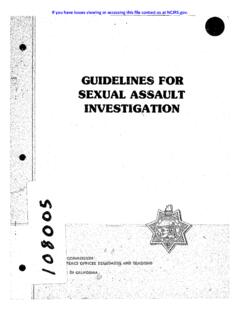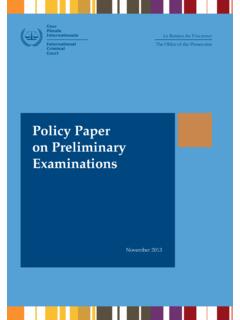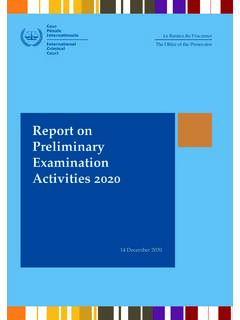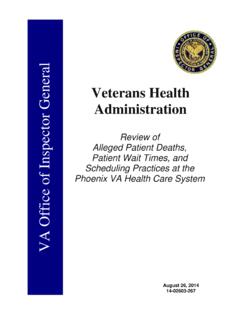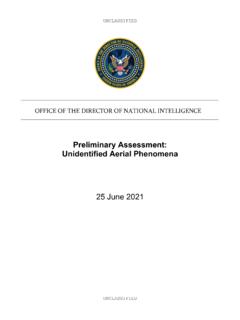Transcription of Crime Scene Investigation - Central Bucks School District
1 Crime SceneInvestigationMarilyn T. MillerIntroductionFrom nanogram quantities of DNA to artificial intelligence data-bases capable of identifying latent fingerprints, forensic scienceand the analysis of very minute quantities of physical evidencehave advanced and improved. Yet, these applications of the scienceare remote from the Crime Scene and its Investigation . Crime sceneinvestigation is the beginning point for the successful use of physicalevidence by the forensic laboratory and the criminal more than ever, the Scene of a Crime must always be properlymanaged and investigated in the best possible , high quality Crime Scene Investigation is a simple,methodical process. It is not rigid; it follows a set of principles andprocedures that are reasonable and ensure that all physical evidenceis discovered and investigated with the result that justice is basic Crime Scene procedures are physical evidencerecognition, documentation, proper collection, packaging, preser-vation, and, finally, Scene reconstruction.
2 Every Crime Scene isunique and, with experience, a Crime Scene investigator will be ableto use this logical and systematic approach to investigate even themost challenging Crime scenes to a successful a Crime SceneThe only thing consistent about Crime scenes is their of their diversity, Crime scenes can be classified in manyways. First, Crime scenes can be classified according to the location ofthe original criminal activity. This classification of the Crime scenelabels the site of the original or first criminal activity as the pri-mary Crime Scene and any subsequent Crime scenes as classification does not infer any priority or importance to thescene, but is simply a designation of sequence of *t93-1246-9AB/$ +$ by CRC Press LLC115 Forensic Science: An Introduction to Scientific and Investigative Techniquesi ^s_ ___ _____ jp, OUOf.,x ^kPhysical Evidence> Ob/\ \rpSr116gunshot residue, etc.
3 Are especially well suitedfor determination of The identification of unknown substancesis a common use of physical of drugs, poisons, and evenbacteria such as anthrax are good step in the forensic examination Crime Scene investigator is frequentlymore interested in how a Crime occurred thanidentifying or individualizing the evidence atthe Scene . The "how" of the Crime Scene ismore important than the "who."Science and Crime SceneInvestigationsComparison TestingEvaluationInterpretationReporting and PresentationFigure Steps to the scientific examination of acrime Crime SceneProceduresScene ManagementCrimes today are solved by the teamwork ofinvestigators and Crime Scene personnel andby the combined use of techniques and proce-dures recognizing the power of Crime scenes,physical evidence, records, and , numerous cases, routine andcomplex, have shown that despite availablecrime Scene technologies and specially trainedpersonnel, the productiveness of a Crime sceneinvestigation is only as good as the supportivemanagement team.
4 The four distinctive butinterrelated components of 1. Information management2. Manpower management3. Technology management4. Logistics managementDeficiencies, negligence, and overemphasisof any one of these components will imperil theoverall Crime Scene Investigation . Thesecomponents are all based on the fundamentalneed for good and ongoing communicationFirst Responding OfficersThe first responders at a Crime Scene are usually police officers, fire department personneor emergency medical personnel. They are thonly people who view the Crime Scene in itoriginal condition. Their actions at the crimscene provide the basis for the successful cunsuccessful resolution of the investigatioiThey must perform their duties and remenber that they begin the process that links vi<tims to suspects to Crime scenes and musnever destroy the first responders must always mailtain an open and objective mind when a]preaching a Crime Scene .
5 Upon arrival, safelis a primary concern. When the Scene and tlvictim are safe, the first responders mu: Patrol officers and detec- Useful if resources and tivesserve as Crime Scene demand are relatively lowtechnicians118 DescriptionModel TypeDisadvantagesAdvantagesSpecially trained full-time civilian personnelFull-time, sworn officerssiDie, they should initiate Crime scenesecurity measures. The duties of a first re-sponder are to:1. Assist the Search for and arrest the suspect ifstill on the Detain all witnesses because theypossess valuable information aboutthe Crime Scene . Keep witnesses sep-arated to preserve their Protect the Crime Scene . Begin byusing barrier tape, official vehicles, orother means to secure the a Crime Scene security logto record the names of all personswho enter or exit the Crime Scene . Donot smoke, drink, or eat within thesecured Crime Scene and do not allowunnecessary persons or officials toenter or contaminate the Note and communicate to Crime sceneinvestigators all movements andalterations made to the Crime the Crime SceneThe Locard Exchange Principle is the basisfor linking physical evidence from or to thevictim, suspect, and Crime Scene .
6 Anyone en-tering a Crime Scene can alter or change thescene and its evidence, so access to the crimescene must be restricted and, if possible, pre-vented except for essentiial Crime Scene per-sonnel. Any physical barriers like vehicles ortapes that help protect the Crime Scene mustbe established as soon as possible by the Scene barriers have been established,one officer shall be designated as the scenesecurity officer. He or she will be responsiblefor preventing entrance into the Crime Scene bycurious onlookers. A contamination log orsecurity log should be kept to record allentries to and exits from secure areas of thecrime Scene . Use of a multilevel securityapproach can successfully preventFigure Multilevel Crime Scene entries (Figure ). Only in raresituations will the Crime Scene investigator bethe first responder. After he or she arrives, thefirst step is to evaluate the established secureareas and change them if Scene SurveyWhen the Crime Scene investigator has arrivedat the Crime Scene and Scene security has beenevaluated, the preliminary Scene survey or"walk-through" should be done.
7 The crimescene investigator and the first responder willusually perform the Scene survey together. Thelead investigator or detective, if available, canalso benefit from participating. Use of instantphotography for preliminary documentationcan be helpful. The survey is the firstexamination or orientation by the Crime sceneinvestigator and the following guidelinesshould be followed: Use the walk-through to mentallyprepare a reconstruction theory thatcan and should be changed as thescene Investigation progresses. Note any transient (temporary) orconditional (the result of an action)evidence that requires immediateprotection or processing. Be aware of weather conditions andtake precautions if protection. Be aware of alterations orcontaminations of these areas by firstresponder personnel. Record initialobservations of who, what, where,when, and how. Assess the Scene forpersonnel, precautions, or equipmentthat will be needed and notify superiorofficers or other agencies as Scene DocumentationAfter a Crime Scene has been evaluated by apreliminary Scene survey, the Crime Scene 'scondition must be documented (Figure ).
8 Documentation is the most important step inthe processing of the Crime Scene . The purposeof documentation is to permanently record thecondition of the Crime Scene and its physicalevidence. It is the most time-consumingactivity at the Scene and requires the investi-gator to remain organized and systematicthroughout the process. Innovation and origi-nality are also needed. The four major tasks ofdocumentation are note taking, videography,photography, and sketching. All four are nec-essary and none is an adequate substitute foranother. For example, notes are not substitutesfor , in all its various forms, be-gins with the initial involvement of the inves-tigator. The documentation never stops; it mayslow down, but the need for documentation re-mains constant. Crime Scene documentationwill be discussed below in the sequence itshould follow at a Crime Scene . The systematicprocess presented will maintain the organizednature of scientific Crime Scene Notes at the Crime SceneEffective notes as part of an Investigation pro-vide a written record of all of the Crime sceneactivities.
9 The notes are taken as the activitiesare completed to prevent possible memoryloss if notes are made at a later time. Accuratecrime Scene note taking is crucial atsider the who, what, when, why, and how, andspecifically include: Notification information. Date andtime, method of notification, and in-formation received. Arrival information. Means ofpointsof entry), containers holdingevidence of recent activities (ash-trays, trash cans, etc.), clothing, fur-niture, and weapons present. Victim description. In most jurisdic-tions a body should not be moved ordisturbed until the medical examinerhas given approval, after which notescan be made of position, livid-ity,wounds, clothing, jewelry, andidentification (presence or absence). Crime Scene team. Assignments toVideotaping the Crime SceneVideotaping a Crime Scene has become a rou-tine documentation procedure. Its acceptanceis widespread, due to the three-dimensionalportrayal of the Scene and increased avail-ability of affordable equipment with user-friendly features like zoom lens and compactsize.
10 Jury acceptability and expectation havealso added to the recognized use of videogra-phy in Crime Scene of the Crime Scene should fol-low the Scene survey. The videotaping of crimescenes is an orientation format. The operatorshould remain objective in recording thecrime Scene . The videotape should not show Forensic Science: An Introduction to Scientific and Investigative TechniquesPhotographing the Crime Scenecific items of evidence that may be used foanalysis away from the Scene . The number ophotographs that should be taken at a crimscene cannot be predetermined or limited, icrime Scene investigator should never doutwhether a photo should be taken it shoulalways be taken. Table shows guidelinethat should be followed when photographin acrime photograph taken at a Crime seenmust be recorded in a photo log. The kshould show the time and date the photigraph was taken, the roll number, the expisure number, the camera settings (f-stoshutter speed), an indication of distance 1 General or Overall PhotosMidrange Photo(/122 Figure (A) Closeup photograph of tire tread mark insnow.)












